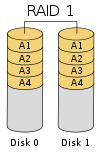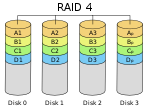JBOD
(J ust a B unch O f D isks)在某些分类上,JBOD并不算是 RAID的等级。只是将多个磁盘空间合并成一个大的逻辑磁盘,不具有错误备援机制。数据的存放机制是由第一颗磁盘开始依序往后存放,即操作系统看到的是一 个大磁盘(由许多小磁盘组成)。但如果磁盘损毁,则该颗硬盘上的所有数据将无法救回。若第一颗硬盘损坏,通常无法作救援(因大部分文件系统将文件表存在磁 盘前端,即第一颗),失去文件表即失去一切数据。
RAID 0
将多个磁盘合并成一个大的磁盘,不具有冗余,并行I/O , 速度最快。RAID 0亦称为带区集。它是将多个磁盘并列起来,成为一个大磁盘。在存放数据时,其将数据按磁盘的个数来进行分段,然后同时将这些数据写进这些盘中。 所以,在所有的级别中,RAID 0的速度是最快的。但是RAID 0没有冗余功能,如果一个磁盘(物理)损坏,则所有的数据都会丢失。
理论上越多的磁盘效能就等于[单一磁盘效能]x[磁盘数],但实际上受限于总线 I/O 瓶颈及其它因素的影响,RAID 效能会随边际递减,也就是说,假设一个磁盘的效能是50MB/秒,两个磁盘的RAID 0效能约96MB/秒,三个磁盘的RAID 0也许是130MB/秒而不是150MB/秒。所以,两个磁盘的RAID 0最能明显感受到效能的提升。
但如果是以软件方式来实现RAID,则磁盘的空间则不见得受限于此(例如Linux Software RAID),通过软件实现可以经由不同的组合而善用所有的磁盘空间。
RAID 1
两组以上的N个磁盘相互作镜像 , 速度没有提高,除非拥有相同数据的主磁盘与镜像同时损坏,否则最高可坏剩N个磁盘,可靠性最高。RAID 1就是镜像。其原理为在主硬盘上存放数据的同时也在镜像硬盘上写一样的数据。当主硬盘(物理)损坏时,镜像硬盘则代替主硬盘的工作。因为有镜像硬盘做数据 备份,所以RAID 1的数据安全性在所有的RAID级别上来说是最好的。但无论用多少磁盘做RAID 1,仅算一个磁盘的容量,是所有RAID上磁盘利用率最低的一个级别。
RAID 2
这是RAID 0的改良版,以汉明码 (Hamming Code )的方式将数据进行编码后分割为独立的位,并将数据分别写入硬盘中。因为在数据中加入了错误修正码(ECC,Error Correction Code),所以数据整体的容量会比原始数据大一些,RAID2最少要三台磁盘驱动器方能运作。
RAID 3
采用Bit-interleaving(数据交错存储)技术,它需要通过编码再将数据位分割后分别存在硬盘中,而将同位检查后单独存在一个硬盘中, 但由于数据内的位分散在不同的硬盘上,因此就算要读取一小段数据资料都可能需要所有的硬盘进行工作,所以这种规格比较适于读取大量数据时使用。
RAID 4
它与RAID 3不同的是它在分割时是以区块为单位分别存在硬盘中,但每次的数据访问都必须从同位检查的那个硬盘中取出对应的同位数据进行核对,由于过于频繁的使用,所以对硬盘的损耗可能会提高。(Block interleaving)
RAID 5
RAID Level 5 是一种存储性能、数据安全和存储成本兼顾的存储解决方案。它使用的是Disk Striping(硬盘分割)技术。RAID 5 至少需要三颗硬盘, RAID 5不对存储的数据进行备份,而是把数据和相对应的奇偶校验信息存储到组成RAID5的各个磁盘上,并且奇偶校验信息和相对应的数据分别存储于不同的磁盘 上。当RAID5的一个磁盘数据发生损坏后,利用剩下的数据和相应的奇偶校验信息去恢复被损坏的数据。 RAID 5可以理解为是RAID 0和RAID 1的折衷方案。RAID 5可以为系统提供数据安全保障,但保障程度要比镜像 低 而磁盘空间利用率要比镜像高。RAID 5具有和RAID 0相近似的数据读取速度,只是多了一个奇偶校验信息,写入数据的速度相当的慢,若使用“回写高速缓存”可以让效能改善不少。同时由于多个数据对应一个奇偶 校验信息,RAID 5的磁盘空间利用率要比RAID 1高,存储成本相对较便宜。
RAID 6
与RAID 5相比,RAID 6增加了第二个独立的奇偶校验信息块。两个独立的奇偶系统使用不同的算法,数据的可靠性非常高,即使两块磁盘同时失效也不会影响数据的使用。但RAID 6需要分配给奇偶校验信息更大的磁盘空间,相对于RAID 5有更大的“写损失”,因此“写性能”非常差。较差的性能和复杂的实施方式使得RAID 6很少得到实际应用。
同一数组中容许两个硬盘同时失效(或是当一个失效后还来不及更换便有第二个失效)后。更换新硬盘时再由另两个正常硬盘将备份的数据建立在新的硬盘中。所以至少必须具备四或四个以上硬盘才能生效。
RAID 7
这是一种新的RAID标准,其自身带有智能化即时操作系统和用于存储管理的软件工具,可完全独立于主机运行,不占用主机CPU资源。RAID 7可以看作是一种存储计算机(Storage Computer),它与其他RAID标准有明显区别。
RAID 10/01
RAID 10/01其实可细分为RAID 1+0或RAID 0+1。
RAID 1+0是先镜射再分割数据。是将所有硬盘分为两组,视为是RAID 0的最低组合,然后将这两组各自视为RAID 1运作。RAID 1+0有着不错的读取速度,而且拥有比RAID 0更高的数据保护性。
RAID 0+1则是跟RAID 1+0的程序相反,是先分割再将数据镜射到两组硬盘。它将所有的硬盘分为两组,变成RAID 1的最低组合,而将两组硬盘各自视为RAID 0运作。RAID 0+1比起RAID 1+0有着更快的读写速度,不过也多了一些会让整个硬盘组停止运转的机率;因为只要同一组的硬盘全部损毁,RAID 0+1就会停止运作,而RAID 1+0则可以在牺牲RAID 0的优势下正常运作。
RAID 10巧妙的利用了RAID 0的速度以及RAID 1的保护两种特性,不过它的缺点是需要的硬盘数较多,因为至少必须拥有四个以上的偶数硬盘才能使用。
RAID 50
RAID50也被称为镜象阵列条带,由至少六块硬盘组成,象RAID0一样,数据被分割成条带,在同一时间内向多块磁盘写入;象RAID5一样,也是以数据的校验位来保证数据的安全,且校验条带均匀分布在各个磁盘上。其目的在于提高RAID5的读写性能。
应用
RAID4有应用在某些商用机器上,像是NetApp公司设计的NAS系统就是使用RAID4的设计概念
A number of standard schemes have evolved which are referred to as levels . There were five RAID levels originally conceived, but many more variations have evolved, notably several nested levels and many non-standard levels (mostly proprietary ).
Following is a brief summary of the most commonly used RAID levels.[3] Space efficiency is given as amount of storage space available in an array of n disks, in multiples of the capacity of a single drive. For example if an array holds n=5 drives of 250GB and efficiency is n-1 then available space is 4 times 250GB or roughly 1TB.
| Level | Description | Minimum # of disks | Space Efficiency | Image |
|---|---|---|---|---|
| RAID 0 | "Striped set without parity " or "Striping ". Provides improved performance and additional storage but no redundancy or fault tolerance. Because there is no redundancy, this level is not actually a Redundant Array of Inexpensive Disks, i.e. not true RAID. However, because of the similarities to RAID (especially the need for a controller to distribute data across multiple disks), simple strip sets are normally referred to as RAID 0. Any disk failure destroys the array, which has greater consequences with more disks in the array (at a minimum, catastrophic data loss is twice as severe compared to single drives without RAID). A single disk failure destroys the entire array because when data is written to a RAID 0 drive, the data is broken into fragments. The number of fragments is dictated by the number of disks in the array. The fragments are written to their respective disks simultaneously on the same sector. This allows smaller sections of the entire chunk of data to be read off the drive in parallel, increasing bandwidth. RAID 0 does not implement error checking so any error is unrecoverable. More disks in the array means higher bandwidth, but greater risk of data loss.
| 2 | n |  |
| RAID 1 | 'Mirrored set without parity' or 'Mirroring ' . Provides fault tolerance from disk errors and failure of all but one of the drives. Increased read performance occurs when using a multi-threaded operating system that supports split seeks, as well as a very small performance reduction when writing. Array continues to operate so long as at least one drive is functioning. Using RAID 1 with a separate controller for each disk is sometimes called duplexing .
| 2 | 1 (size of the smallest disk) |  |
| RAID 2 | Hamming code parity . Disks are synchronized and striped in very small stripes, often in single bytes/words. Hamming codes error correction is calculated across corresponding bits on disks, and is stored on multiple parity disks.
| 3 | ||
| RAID 3 | Striped set with dedicated parity or bit interleaved parity or byte level parity . This mechanism provides fault tolerance similar to RAID 5. However, because the strip across the disks is a lot smaller than a filesystem block, reads and writes to the array perform like a single drive with a high linear write performance. For this to work properly, the drives must have synchronised rotation. If one drive fails, the performance doesn't change.
| 3 | n-1 |  |
| RAID 4 | Block level parity. Identical to RAID 3, but does block-level striping instead of byte-level striping. In this setup, files can be distributed between multiple disks. Each disk operates independently which allows I/O requests to be performed in parallel, though data transfer speeds can suffer due to the type of parity. The error detection is achieved through dedicated parity and is stored in a separate, single disk unit.
| 3 | n-1 |  |
| RAID 5 | Striped set with distributed parity or interleave parity . Distributed parity requires all drives but one to be present to operate; drive failure requires replacement, but the array is not destroyed by a single drive failure. Upon drive failure, any subsequent reads can be calculated from the distributed parity such that the drive failure is masked from the end user. The array will have data loss in the event of a second drive failure and is vulnerable until the data that was on the failed drive is rebuilt onto a replacement drive. A single drive failure in the set will result in reduced performance of the entire set until the failed drive has been replaced and rebuilt.
| 3 | n-1 |  |
| RAID 6 | Striped set with dual distributed parity. Provides fault tolerance from two drive failures; array continues to operate with up to two failed drives. This makes larger RAID groups more practical, especially for high availability systems. This becomes increasingly important because large-capacity drives lengthen the time needed to recover from the failure of a single drive. Single parity RAID levels are vulnerable to data loss until the failed drive is rebuilt: the larger the drive, the longer the rebuild will take. Dual parity gives time to rebuild the array without the data being at risk if a (single) additional drive fails before the rebuild is complete. | 4 | n-2 |  |































 3713
3713











 被折叠的 条评论
为什么被折叠?
被折叠的 条评论
为什么被折叠?








